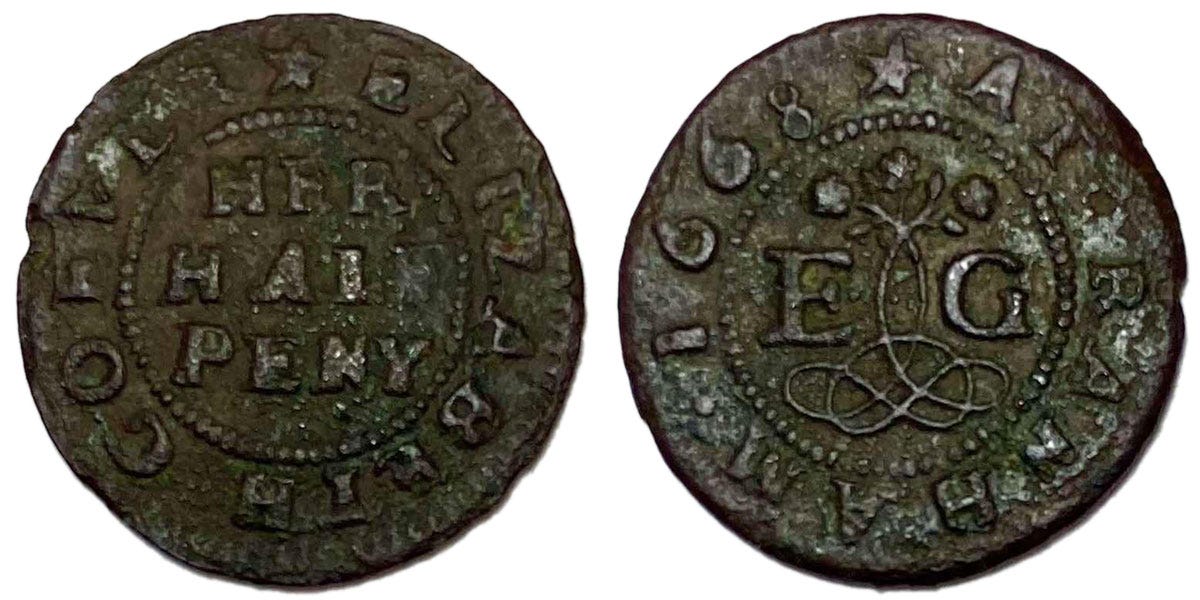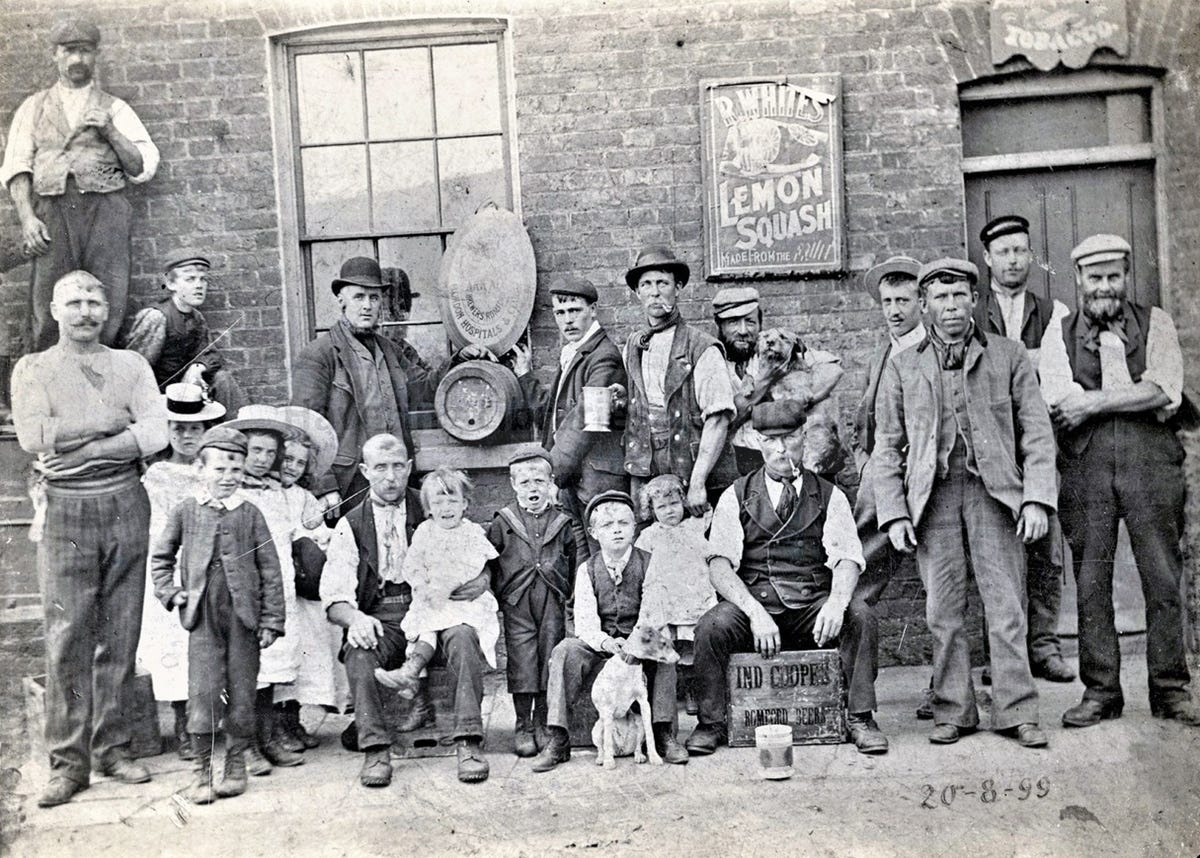Who was Elizabeth Goever?
What can we discover about a woman from only her 17th Century trade token?
In the footpaths in my local village – formerly part of Essex, but now in the far east of Greater London – are a series of round brass plaques. Installed as part of a public art/history project in 2012, they depict the commerce and industry of the area’s past: from butchers and shoemakers to the old wharf and the ‘trolley’ into central London. Among them is a curious recreation of a trade token from 1668.
What’s interesting about the token is that it bears the full name of a woman.
Rainham is an ancient, Thames-side parish in Essex, around 12miles east of the City of London. In 1910, a 17th Century trade token issued by an Elizabeth Goever of Rainham was donated to what is now Colchester Museum. It had previously been examined by the British Museum and declared “the first token yet known of that place”. To this day, it remains the only known token from Rainham, and is all the rarer for belonging to a woman.
An analysis of more than 4,200 surviving trade tokens created in London between 1649-1672 (population: 400,000-475,000), found just 140 (3.4%) featured the full name of women. An analysis of the same data source, focusing on 420 surviving tokens from Essex (population: c160,000) found just 11 (2.6%) featured the full name of women. In Rainham in 1670, two years after Elizabeth issued her token, there were just 44 occupied houses; perhaps around 200 residents.
I imagine Elizabeth standing on the doorstep, or perhaps behind the counter, of her business. She turns over a small, shiny disc in her hands; the cold metallic feel of it a contrast against her warm skin. It’s a ha’penny, ‘her half penny’, a personalised trade token to facilitate the small, day-to-day purchases of her customers at a time when official low-denomination coins are in short supply. Does she smile to herself at the sight of it? Does she feel pride? For no one else in her parish has a business essential enough, successful and stable enough, to warrant the commissioning of a trade token, not even a man.

Between the late 1640s and early 1670s, England’s trade and housekeeping was struggling with a lack of small change. The metal in regal coinage was traditionally expected to match its face value, but as the price of silver rose, it meant coins would have to be made so tiny as to be impractical. While the government considered (or failed to consider) what to do, local authorities, companies, and individuals began producing their own metal tokens as an alternative form of currency. Usually struck in copper or brass, mostly in farthing and halfpenny denominations, they commonly featured the name and initials, occupation, and location of the issuer, along with the year of manufacture, their value, and imagery indicating the issuer’s line of work.
Trade tokens weren’t only an alternative form of currency, they also served as a form of advertising. Inherent in their design – often featuring the street location and/or iconography that may have correlated with shop or drinking establishment signage – was the requirement of a set location. This meant the token issuer needed to own or pay rent on a premises. What this suggests is that Elizabeth was either a widow or an independent, single woman. For at this time, married women were considered ‘femme couverte’, they did not have their own legal identity, but were instead covered under the marital authority of their husband. They would not have been able to enter into contracts to buy or rent property or to buy goods for their business in their own, and would therefore have been unlikely to issue a trade token in their own name.
Unfortunately, the archive is largely silent on the identity, and the milestones of the life, of Elizabeth Goever. We can be confident that she died in early 1702, as there’s a record of an Elizabeth Gover being buried in the church of St Helen and St Giles in Rainham on April 13 of that year. (It was not uncommon for words and names to be spelled in different ways during this period.) This record further suggests her independent, ‘femme sole’, status, as – in contrast to some of the other women on the same and adjacent pages of the parish register – she is referred to by her name alone, not as the ‘wife of’ a man. But we do not know when she was born, how old she was when she issued her trade token, or even the nature of her business.
Unlike many of the surviving 17th Century tokens, Elizabeth’s does not reveal her trade, either in words or symbols. The only clue is the true lover’s knot featured on its reverse. This symbol has been found on other tokens for businesses including mercer, grocer, and haberdasher. However, in these instances, it is not the true lover’s knot which suggests the trade, but the arms of the livery company to which the token issuers belonged, which appears on the obverse. This suggests that the true lover’s knot was more decorative than descriptive. Considering the trades of other women token issuers may provide further clues about Elizabeth. Of the surviving London women’s tokens where a trade is clearly identified by words or symbols, 24 out of 41 (58.5%) are alehouse, tavern, or inn keepers (all other trades have between just 1 and 3 examples). Of the surviving Essex women’s tokens, the token itself and/or further research has identified their trades as alehouse keeper (2 or 3 out of 5), baker (1), shopkeeper (1), and grocer (maybe 1).
Perhaps Rainham’s small population meant that Elizabeth didn’t need to specify her location or profession: everyone in the parish knew who she was, where she was, and what she did. And if indeed the token was more status symbol than advertising material, it is interesting to consider what other role it may have served. Evidence from contemporary commentators and modern experts shows that trade tokens were not only exchanged in the business of the issuer, but would’ve been accepted by other proprietors in the surrounding areas. So, in issuing a token, might Elizabeth have been solving the small change problem not just for her own business, but the other businesses in the parish, too? And how might this have influenced – or reflected – her standing in the community, if it was her initiative, her investment in the production of the tokens, that helped ensure the continued functioning of the local small purchase economy in her parish?
Inhabitants of Rainham in the 17th Century predominantly relied on farming and the waterways for their livelihoods: passengers travelling to and from London and Kent took the ferry from the banks of the Thames in Rainham, while local and inland produce used the wharf in the adjoining Rainham Creek; cattle and sheep grazed on the marshes and arable fields were used to produce grain, beans, peas, hay, and straw. These industries suggest there was probably a butcher shop and a bakery in the parish, and maybe a grocer, too. The first application for an inn was made in 1633 and there were five licenced alehouses in the parish in 1640. Aside from the five or six manor properties and three or four larger farmlands, the majority of buildings – homes and business premises – would likely have been concentrated around the village and church in the southwest corner of the parish (as was the case from the Middle Ages, and as can be seen in early-17th and late-18th Century maps).

Given that the largest majority of surviving trade tokens – including examples that feature the full name of women – were issued by inn and alehouse keepers, and given the evidence of multiple licenced houses in operation in Rainham in the mid-17th Century, it is reasonable to infer that our token issuer may have been the proprietress of such an establishment. (Sadly, records for alcohol licences at the Essex Records Office jump from 1640 to 1713, skipping the period Elizabeth’s token shows she might have been in charge.)
I imagine Elizabeth giving and receiving her trade token from the tied-on linen pockets worn on top of her clothing for ease of repeated access, or perhaps from the sewn-on pockets of an apron, in payment for wooden tankards of drink. Her establishment is the heart of the parish’s social and leisure activities. Elizabeth is firm – she would not survive in this business without knowing how to handle herself, and her customers when necessary – but she is always fair. She knows that people wouldn’t keep coming back if she didn’t give them a reliably welcoming and convivial atmosphere, and serve the plentiful drinks which helped ease the aches after a long days’ work.
I lean in through time and picture all the hands Elizabeth’s token passed through – the ferrymen, the farmers, the wives, and the women in service at the manor houses. I wonder whether, as was a superstition at the time, Elizabeth ever kissed or spat on the token one morning to bring good fortune for the trading day ahead? I see it making its way through palms, pockets, and purses, across the parish, criss-crossing the thresholds of businesses and homes.
Elizabeth Goever’s token cannot speak to the lives of the countless individuals who handled it, or even provide absolute certainty on its issuer’s trade. Nevertheless, it serves as a faint pulse amid an archive of silences, signifying: She existed. She was a business owner. She was a someone in that ancient Thames-side parish of Rainham in the late 17th Century.
(Story updated 4 October 2024 following further research)






